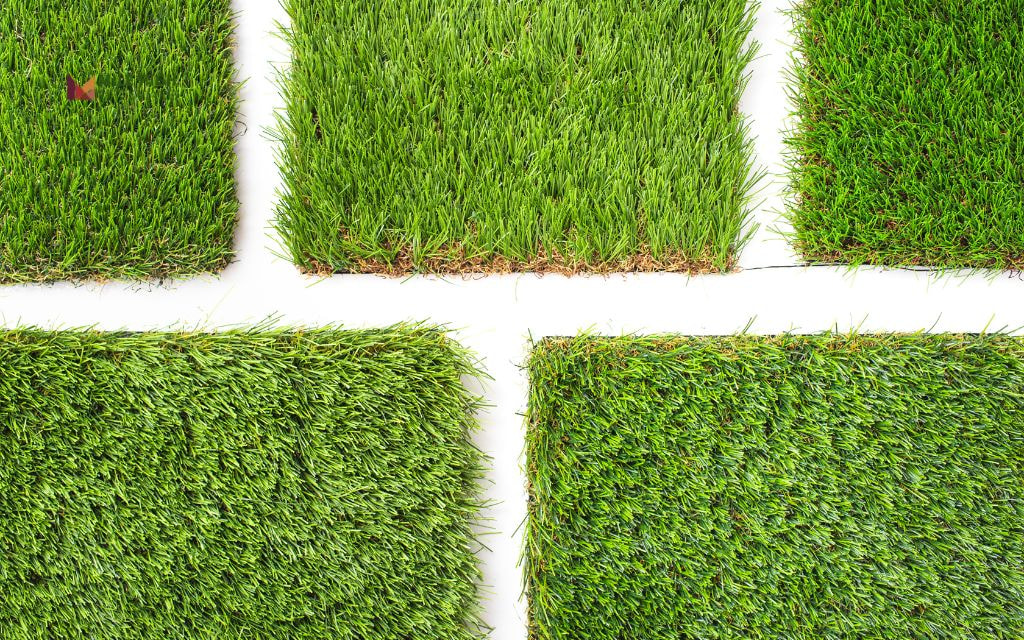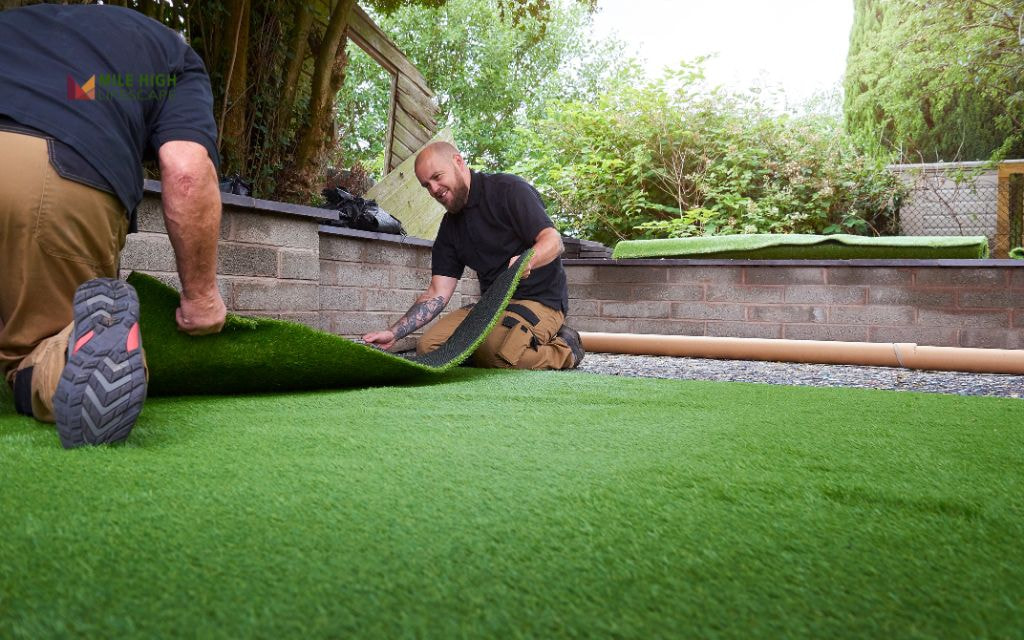In Denver’s semi-arid climate, maintaining a lush, green lawn can be a constant battle against water restrictions, dry spells, and extreme temperature fluctuations. That’s why more and more Denver homeowners are turning to artificial turf as a practical, eco-friendly alternative to natural grass.
In this guide, we’ll walk you through everything you need to know – from how to install artificial turf to proper techniques and ongoing maintenance.
Whether you’re a DIY enthusiast ready to tackle the project yourself or just researching before hiring professionals, this step-by-step resource will help you achieve a beautiful, low-maintenance lawn that stays green year-round.
Types of Artificial Turf: Choosing the Right One for Your Lawn
Not all artificial turf is created equal, and selecting the right type for your specific needs is crucial for long-term satisfaction.
The 3 main materials used in manufacturing artificial turf are polyethylene, polypropylene, and nylon. Each offers different benefits and is suited to different applications:
- Polyethylene (PE) turf is the most popular choice for residential lawns due to its soft, natural appearance and good balance of durability and comfort. It’s ideal for family yards in Denver neighborhoods.
- Polypropylene (PP) turf is the most affordable option but less durable under intense UV exposure, making it better suited for shaded areas or indoor applications in Denver.
- Nylon turf is the most durable and heat-resistant, though typically more expensive. It’s excellent for high-traffic areas and can withstand Denver’s summer heat better than other materials.

| Type of Turf | Ideal Use | Features | Best For Denver |
| Residential Turf | Lawns, Gardens | Soft, natural-looking, moderate durability | Low-maintenance family yards |
| Pet Turf | Pet areas, Dog runs | Enhanced drainage, antimicrobial properties | Homes with dogs |
| Commercial Turf | High-traffic areas | Highly durable, thicker fibers | Public spaces, parks |
| Sports Turf | Athletic fields | Specialized performance, shock absorption | Sports facilities, home putting greens |
| UV-Resistant Turf | Open, sunny areas | Enhanced protection against color fading | Denver’s sun-exposed yards |
When selecting artificial turf in Denver, also consider these important factors:
- Pile height: Ranges from 1-2 inches; shorter piles (1-1.5″) are more durable while taller piles (1.5-2″) look more natural but require more maintenance.
- Blade shape: C-shaped, V-shaped, or W-shaped blades affect how natural the grass looks and how well it springs back after being compressed.
- Infill requirements: Some turfs require more infill material to maintain their appearance and provide proper drainage.
- UV protection: Critical in Denver’s sunny climate to prevent fading and deterioration.
- Warranty: Quality artificial turf should come with at least an 8-10 year warranty, with premium options offering 15+ years.
How Do You Prepare Ground For Artificial Turf?
Proper ground preparation is arguably the most critical part of artificial turf installation, particularly in Denver’s clay-heavy soils that can create drainage challenges.
Skipping or rushing this phase can lead to uneven surfaces, poor drainage, and premature turf failure. Here’s a detailed ground preparation guide:
Step 1: Clear the area
Remove all existing grass, weeds, rocks, and debris to create a clean slate. For Denver lawns, use a sod cutter for efficient removal of existing turf.
Dig down approximately 3-4 inches, which will allow room for your base materials while maintaining proper grade relationships with adjacent hardscapes.
Step 2: Grade and level the ground
Denver’s variable topography requires careful attention to grading. Create a slight slope (about 1-2%) away from structures to ensure proper drainage. Use a rake and shovel to smooth out the area, removing any high spots or filling in low areas. A laser level can be helpful for larger installations to ensure consistency.
Step 3: Install a weed barrier
Denver’s climate can support persistent weed growth. Lay down a professional-grade geotextile fabric to prevent weeds from growing up through your turf.
Make sure edges overlap by at least 3-4 inches and secure with landscape staples or pins.

Step 4: Add a drainage layer
This is especially important for Denver’s clay soils. Add 2-3 inches of crushed rock, decomposed granite, or pea gravel as a base layer. This provides stability and allows water to drain efficiently, preventing pooling during Denver’s occasional heavy rains and rapid snowmelt.
Step 5: Compact the base
Use a plate compactor (available at equipment rental stores) to firmly compact the base material. This creates a solid foundation that will prevent settling and maintain an even surface throughout your turf’s lifespan.
For Denver installations, we recommend making multiple passes in different directions for optimal compaction, particularly important for our expansive soils.
How to Install Artificial Turf: Step-by-Step Guide
Once your ground is properly prepared, you’re ready to install the artificial turf itself. This process requires attention to detail to ensure a natural appearance and long-lasting performance, especially in Denver’s variable climate.
If you’re uncertain about handling any part of the installation process yourself, Mile High Lifescape offers professional installation services throughout the Denver metro area, with expertise tailored to our region’s unique climate and soil conditions.
Step 1: Unroll the turf
Lay the artificial grass rolls out and allow them to acclimate to the environment for at least 1-2 hours. This is particularly important in Denver’s climate, where temperature fluctuations can cause material expansion and contraction.
Position the grass so that the blades face the same direction for a uniform appearance. Ensure the turf extends slightly beyond your desired area to allow for precise trimming later.
Step 2: Trim and fit
Using a sharp utility knife, trim the turf to fit the exact dimensions of your installation area. For intricate cuts around trees, plants, or hardscape features, use a smaller knife for precision.
When cutting, always cut from the back side of the turf for cleaner edges.
In Denver installations, we recommend leaving about a 1/4 inch gap along hardscape edges to allow for expansion during hot summer days.
Step 3: Seam joining
If your installation requires multiple pieces of turf, proper seaming is crucial for a seamless look.
Use seaming tape or specialized outdoor turf adhesive along with joining pins to connect the sections. Position the edges as close as possible without overlapping or forcing the material.
For larger Denver installations, consider renting a specialized seam roller to ensure proper bonding between sections.
Step 4: Secure the turf
Anchor the perimeter of the turf using 6-inch galvanized landscape staples or nails placed every 6-8 inches. Pay special attention to edges and seams.
In Denver’s windy conditions, we recommend additional securing points throughout larger installations, particularly in open areas exposed to our occasional strong winds.
Step 5: Infill application
Spread your chosen infill material (silica sand, rubber granules, or a combination) evenly across the turf surface.
For Denver installations, we typically recommend 2-3 pounds of infill per square foot, applied in several thin layers rather than one thick application.
The infill helps weigh down the turf, supports the grass blades, and provides additional drainage capacity for snow melt and rainfall.
Step 6: Brush and fluff
Use a power broom or stiff-bristled push broom to brush the grass fibers upright and distribute the infill material evenly.
This final step gives your artificial turf a natural, fluffed appearance and ensures the blades stand upright. In Denver’s dry climate, lightly misting the surface with water during this process can help settle the infill and reduce dust.

Post-Installation Care for Artificial Turf
One of the biggest advantages of artificial turf in Denver is its minimal maintenance requirements compared to natural grass.
However, some basic care routines will help maintain its appearance and extend its lifespan, particularly important given Denver’s extreme weather conditions.
- Regular debris removal: Use a leaf blower or plastic rake to remove leaves, twigs, and other organic matter. In fall, this is particularly important with Denver’s changing seasons and falling leaves.
- Periodic rinsing: During dry, dusty periods common in Denver summers, rinse your turf occasionally with a garden hose to remove dust and pollen. This simple step can substantially improve appearance and reduce allergens.
- Brush as needed: For high-traffic areas, use a stiff brush (not wire) to fluff up the fibers and prevent matting. Brushing against the grain helps maintain that natural, upright appearance.
- Snow removal: After Denver snowfalls, allow snow to melt naturally when possible. If removal is necessary, use a plastic shovel and work carefully to avoid damaging the turf. Never use metal shovels or snow blowers.
- Pet waste management: For homes with pets, promptly remove solid waste and rinse urine spots with water. For persistent odors, use a specialized enzymatic cleaner designed for artificial turf.
- Weed prevention: While the weed barrier installed during preparation helps significantly, occasional weeds may appear at edges. Remove them promptly by hand or with an eco-friendly weed killer approved for use with artificial turf.
- Infill replenishment: Every 1-2 years, check infill levels and add more if needed, particularly after Denver’s heavy rain seasons which may displace some material.
With proper care, quality artificial turf in Denver should maintain its appearance and functionality for 10-15+ years, depending on usage patterns and the specific product installed.
This makes it an excellent long-term investment for Colorado homeowners looking to reduce lawn maintenance while maintaining curb appeal.
Remember that while artificial turf is highly durable, avoid placing extremely hot items (like grills) directly on the surface, as they can potentially melt the fibers.
Cost of Installing Artificial Turf in Denver
When budgeting for artificial turf installation in Denver, it’s important to consider both the initial investment and the long-term cost savings on water, maintenance, and lawn care products.
Cost Breakdown
| Cost Component | Price Range (per sq. ft.) | Notes for Denver |
| Turf Materials | $2 – $8 | Higher-quality UV-resistant varieties recommended for Denver’s sunny climate |
| Base Materials | $0.50 – $2 | Additional drainage materials often needed for Denver’s clay soils |
| Professional Installation | $3 – $8 | Varies based on yard accessibility and complexity |
| Removal of Existing Lawn | $1 – $3 | May be higher for difficult-to-remove vegetation |
| Edging and Borders | $2 – $5 (linear ft.) | Optional but recommended for clean installation |
Total Average Cost:
- DIY Installation: $5 – $10 per square foot
- Professional Installation: $9 – $20 per square foot
For a standard 500 sq. ft. Denver backyard, expect total costs of:
- DIY: $2,500 – $5,000
- Professional: $4,500 – $10,000
Long-Term Cost Savings
While the initial investment is significant, Denver homeowners typically recoup their costs through:
- Water savings: $300-$600+ annually based on typical Denver water rates and lawn size
- Lawn care equipment: No need for mowers, trimmers, or fuel
- Fertilizers and treatments: $200-$400 annually
- Professional lawn services: $800-$2,000+ annually if previously outsourced
- Time savings: 40+ hours annually of maintenance time
Most Denver homeowners find that their artificial turf installation pays for itself within 3-7 years, depending on previous lawn maintenance costs and the size of the installation. Additionally, artificial turf can increase property values and improve curb appeal, particularly in Denver neighborhoods where water-efficient landscaping is increasingly valued.
At Mile High Lifescape, we offer free consultations and estimates to help you understand the specific costs for your property based on size, current conditions, and your turf preferences.
Mile High Lifescape Professional Installation
At Mile High Lifescape, we’ve been installing artificial turf in Denver homes for over 20 years. Our team of landscape professionals understands the unique challenges of Denver’s climate and soil conditions.
We offer comprehensive artificial turf solutions that include:
- Free on-site consultations and estimates
- Custom design services to maximize your outdoor space
- Premium-quality turf products with industry-leading warranties
- Expert installation by trained professionals
- Complete project management from start to finish
Contact us for a free consultation to discuss your artificial turf project and learn how our expertise can help you achieve a beautiful, low-maintenance lawn that will look great for years to come.
Conclusion
The key to successful artificial turf installation lies in proper preparation, quality materials, and attention to detail throughout the process.
Denver’s unique climate considerations – from intense UV exposure to freeze-thaw cycles – make proper installation techniques particularly important for long-term satisfaction.
As water conservation becomes increasingly important in the Denver metro area, artificial turf offers an environmentally responsible alternative to water-intensive natural lawns. With advances in manufacturing technology, today’s synthetic grass options provide realistic appearance and texture while requiring minimal maintenance.
Whether you’re ready to begin your artificial turf project or still researching options, Mile High Lifescape is here to help with expert advice, quality products, and professional installation services tailored to Denver’s unique landscape needs.
Frequently Asked Questions (FAQs)
What do you put underneath artificial turf?
In Denver installations, we typically use a layered base system that includes a geotextile weed barrier directly on the soil, followed by 3-4 inches of compacted crushed stone or decomposed granite for drainage and stability. For enhanced comfort, some installations also include a shock pad layer beneath the turf, particularly in play areas or where pets will be active.
Can I install artificial turf myself?
Yes, DIY installation is possible for smaller, less complex areas if you have the proper tools and skills. However, proper base preparation is crucial, particularly in Denver’s clay soils. Most homeowners find that areas larger than 500 square feet or installations with drainage challenges benefit from professional expertise to ensure long-lasting results.
What is the best base for artificial grass in Denver?
The ideal base for Denver installations is a 3-4 inch layer of class II road base or 3/8″ minus decomposed granite, thoroughly compacted to create a firm, slightly permeable foundation. This provides stability while allowing proper drainage, which is essential given Denver’s clay soils and occasional heavy precipitation or snow melt.
Will my artificial turf get too hot in Denver’s summer?
Artificial turf can heat up significantly on hot, sunny days, sometimes reaching temperatures 20-50°F higher than natural grass. In Denver’s climate, consider turf products with cooling technology or lighter colored fibers to minimize heat retention. Regular misting with water can temporarily cool the surface during the hottest parts of the day if needed.
Can I lay artificial grass on soil directly?
While technically possible, installing artificial grass directly on soil is not recommended in Denver due to our clay-heavy soils and variable weather conditions. Without a proper base, you’ll likely experience drainage issues, uneven settling, weed growth, and premature deterioration of your turf. The proper base preparation described in this guide is essential for long-term satisfaction.
